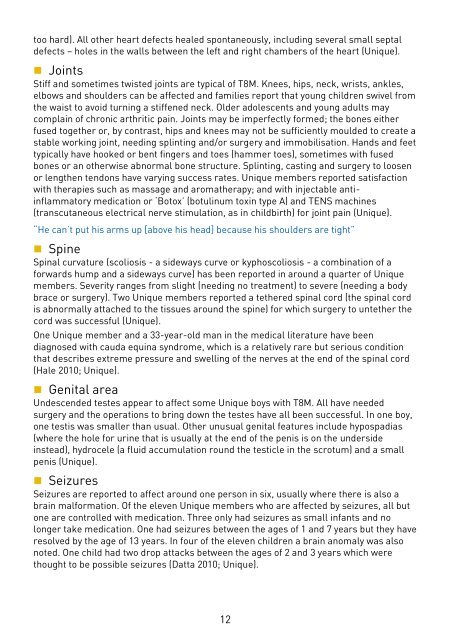Trisomy 8 Mosaicism - Unique - The Rare Chromosome Disorder ...
Trisomy 8 Mosaicism - Unique - The Rare Chromosome Disorder ...
Trisomy 8 Mosaicism - Unique - The Rare Chromosome Disorder ...
You also want an ePaper? Increase the reach of your titles
YUMPU automatically turns print PDFs into web optimized ePapers that Google loves.
too hard). All other heart defects healed spontaneously, including several small septal<br />
defects – holes in the walls between the left and right chambers of the heart (<strong>Unique</strong>).<br />
• Joints<br />
Stiff and sometimes twisted joints are typical of T8M. Knees, hips, neck, wrists, ankles,<br />
elbows and shoulders can be affected and families report that young children swivel from<br />
the waist to avoid turning a stiffened neck. Older adolescents and young adults may<br />
complain of chronic arthritic pain. Joints may be imperfectly formed; the bones either<br />
fused together or, by contrast, hips and knees may not be sufficiently moulded to create a<br />
stable working joint, needing splinting and/or surgery and immobilisation. Hands and feet<br />
typically have hooked or bent fingers and toes (hammer toes), sometimes with fused<br />
bones or an otherwise abnormal bone structure. Splinting, casting and surgery to loosen<br />
or lengthen tendons have varying success rates. <strong>Unique</strong> members reported satisfaction<br />
with therapies such as massage and aromatherapy; and with injectable antiinflammatory<br />
medication or ‘Botox’ (botulinum toxin type A) and TENS machines<br />
(transcutaneous electrical nerve stimulation, as in childbirth) for joint pain (<strong>Unique</strong>).<br />
“He can’t put his arms up [above his head] because his shoulders are tight”<br />
• Spine<br />
Spinal curvature (scoliosis - a sideways curve or kyphoscoliosis - a combination of a<br />
forwards hump and a sideways curve) has been reported in around a quarter of <strong>Unique</strong><br />
members. Severity ranges from slight (needing no treatment) to severe (needing a body<br />
brace or surgery). Two <strong>Unique</strong> members reported a tethered spinal cord (the spinal cord<br />
is abnormally attached to the tissues around the spine) for which surgery to untether the<br />
cord was successful (<strong>Unique</strong>).<br />
One <strong>Unique</strong> member and a 33-year-old man in the medical literature have been<br />
diagnosed with cauda equina syndrome, which is a relatively rare but serious condition<br />
that describes extreme pressure and swelling of the nerves at the end of the spinal cord<br />
(Hale 2010; <strong>Unique</strong>).<br />
• Genital area<br />
Undescended testes appear to affect some <strong>Unique</strong> boys with T8M. All have needed<br />
surgery and the operations to bring down the testes have all been successful. In one boy,<br />
one testis was smaller than usual. Other unusual genital features include hypospadias<br />
(where the hole for urine that is usually at the end of the penis is on the underside<br />
instead), hydrocele (a fluid accumulation round the testicle in the scrotum) and a small<br />
penis (<strong>Unique</strong>).<br />
• Seizures<br />
Seizures are reported to affect around one person in six, usually where there is also a<br />
brain malformation. Of the eleven <strong>Unique</strong> members who are affected by seizures, all but<br />
one are controlled with medication. Three only had seizures as small infants and no<br />
longer take medication. One had seizures between the ages of 1 and 7 years but they have<br />
resolved by the age of 13 years. In four of the eleven children a brain anomaly was also<br />
noted. One child had two drop attacks between the ages of 2 and 3 years which were<br />
thought to be possible seizures (Datta 2010; <strong>Unique</strong>).<br />
12

















